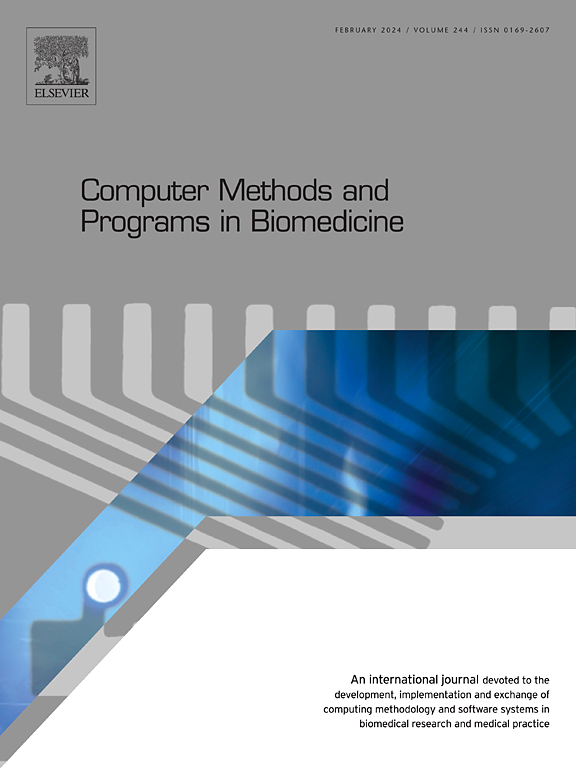HR-pQCT膝关节图像中关节周围骨微结构的自动定量分析
IF 4.9
2区 医学
Q1 COMPUTER SCIENCE, INTERDISCIPLINARY APPLICATIONS
引用次数: 0
摘要
应用HR-pQCT对膝关节进行成像需要开发和验证新的图像分析工作流程。在这里,我们提出并验证了第一个用于膝关节关节周围骨密度和微结构体内定量评估的自动化工作流程。首先用桡骨和胫骨图像(N= 2598)训练分割模型,然后用膝关节图像(N=131)对分割模型进行微调。基于图谱的配准用于创建内侧和外侧接触面掩模,并将其与骨分割相结合以生成感兴趣的关节周围区域掩模。工作流程的准确性和精密度分别用外部验证数据集(N=128)和三次重复测量数据集(N=29)进行评估。预测形态学参数和参考形态学参数的线性决定系数在0.86和0.99之间,对软骨下骨板密度和厚度的预测存在中度偏差。所有区室和所有形态参数的平均短期精密度RMS%CV估计范围为1.0%至2.9%。背景与目的:人们对应用HR-pQCT对膝关节进行成像越来越感兴趣,特别是在骨关节炎的研究中。这就需要开发和验证适合膝关节HR-pQCT图像的新型图像分析工作流程。在这项工作中,我们提出并验证了第一个完全自动化的工作流程,用于人体膝关节关节周围骨密度和微结构的体内定量评估。方法:骨分割模型采用迁移学习训练方法,使用大型桡骨和胫骨图像数据集(N= 2598)进行训练,并对膝关节图像数据集(N=131)进行微调。创建胫骨和股骨地图集,并使用基于地图集的配准来识别内侧和外侧接触面。形态学操作结合骨分割和atlas生成的接触面掩模,生成关节周围感兴趣区域的掩模,其中应用标准形态学分析。使用包含股骨和胫骨的外部验证数据集(N=128)和仅包含胫骨的三次重复测量数据集(N=29)分别评估估计形态学参数的准确性和精度。结果:在外部验证数据集中,预测形态学参数和参考形态学参数表现出良好的一致性(0.86≤R2≤0.99),在预测软骨下骨板密度(−80 mg HA/cm3)和厚度(+0.15 mm)时存在适度偏差。在参与者内部刚性注册中,所有骨室的平均短期精度RMS%CV估计分别为软骨下骨板密度和厚度的2.2%和2.8%,以及小梁密度、分离、厚度和数量的1.1%、2.9%、1.0%和2.9%。结论:我们开发并评估了膝关节HR-pQCT图像关节周围分析的自动化工作流程,整合了深度学习、基于图谱的分割和标准图像处理方法。代码、地图集和模型已经免费提供给其他研究人员使用、改进或扩展。未来的工作将侧重于将工作流程应用于临床数据以研究骨关节炎的病因。本文章由计算机程序翻译,如有差异,请以英文原文为准。
Automated quantitative analysis of peri-articular bone microarchitecture in HR-pQCT knee images
Applying HR-pQCT to image the knee necessitates the development and validation of novel image analysis workflows. Here, we present and validate the first automated workflow for in vivo quantitative assessment of peri-articular bone density and microarchitecture in the knee. Segmentation models were first trained with radius and tibia images (N=2,598) then fine-tuned with knee images (N=131). Atlas-based registration was used to create medial and lateral contact surface masks, which were combined with bone segmentations to generate peri-articular regions of interest masks. The accuracy and precision of the workflow was assessed with an external validation dataset (N=128) and a triple-repeat measures dataset (N=29), respectively. Predicted and reference morphological parameters had linear coefficients of determination between 0.86 and 0.99, with moderate bias present in predictions of subchondral bone plate density and thickness. The average short-term precision RMS%CV estimates across all compartments and all morphological parameters ranged from 1.0 % to 2.9 %.
Background and Objective:
There is growing interest in applying HR-pQCT to image the knee, particularly in the study of osteoarthritis. This necessitates the development and validation of novel image analysis workflows tailored to knee HR-pQCT images. In this work, we present and validate the first fully automated workflow for in vivo quantitative assessment of peri-articular bone density and microarchitecture in the human knee.
Methods:
Bone segmentation models were trained by transfer learning with a large dataset of radius and tibia images (N=2,598) and fine-tuned on a knee image dataset (N=131). Tibia and femur atlases were created and atlas-based registration was used to identify medial and lateral contact surfaces. Morphological operations combined bone segmentations and atlas-generated contact surface masks to generate peri-articular regions of interest masks, in which standard morphological analysis was applied. The accuracy and precision of estimated morphological parameters was assessed with an external validation dataset containing femurs and tibiae (N=128) and a triple-repeat measures dataset containing only tibiae (N=29), respectively.
Results:
On the external validation dataset, predicted and reference morphological parameters showed excellent correspondence (0.86 R 0.99), with moderate bias present in predictions of subchondral bone plate density (−80 mg HA/cm) and thickness (+0.15 mm). With intra-participant rigid registration, the average short-term precision RMS%CV estimates across all compartments were 2.2 % and 2.8 % for subchondral bone plate density and thickness, respectively, and 1.1 %, 2.9 %, 1.0 %, and 2.9 % for trabecular density, separation, thickness, and number, respectively.
Conclusion:
We have developed and evaluated an automated workflow for peri-articular analysis of knee HR-pQCT images, integrating deep learning, atlas-based segmentation, and standard image processing approaches. The code, atlases, and models have been made freely available for other researchers to use, improve, or extend. Future work will focus on the application of the workflow to clinical data to investigate osteoarthritis etiology.
求助全文
通过发布文献求助,成功后即可免费获取论文全文。
去求助
来源期刊

Computer methods and programs in biomedicine
工程技术-工程:生物医学
CiteScore
12.30
自引率
6.60%
发文量
601
审稿时长
135 days
期刊介绍:
To encourage the development of formal computing methods, and their application in biomedical research and medical practice, by illustration of fundamental principles in biomedical informatics research; to stimulate basic research into application software design; to report the state of research of biomedical information processing projects; to report new computer methodologies applied in biomedical areas; the eventual distribution of demonstrable software to avoid duplication of effort; to provide a forum for discussion and improvement of existing software; to optimize contact between national organizations and regional user groups by promoting an international exchange of information on formal methods, standards and software in biomedicine.
Computer Methods and Programs in Biomedicine covers computing methodology and software systems derived from computing science for implementation in all aspects of biomedical research and medical practice. It is designed to serve: biochemists; biologists; geneticists; immunologists; neuroscientists; pharmacologists; toxicologists; clinicians; epidemiologists; psychiatrists; psychologists; cardiologists; chemists; (radio)physicists; computer scientists; programmers and systems analysts; biomedical, clinical, electrical and other engineers; teachers of medical informatics and users of educational software.
 求助内容:
求助内容: 应助结果提醒方式:
应助结果提醒方式:


